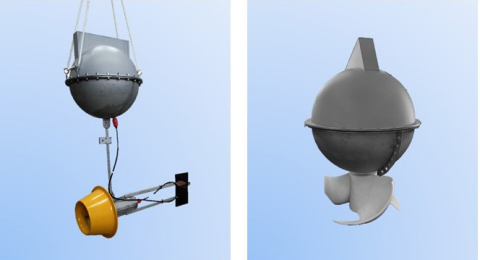Kyocera and Nagasaki University Energy Smart Buoy
- September 7, 2021
- William Payne

Nagasaki University and Kyocera Corporation are developing an energy harvesting smart buoy, which combines Nagasaki University’s tidal current power generation technology with Kyocera’s IoT technology to collect reliable ocean data.
Prototype buoys can collect a range of data on the marine environment using self-generated energy. A pilot programme gathered information from 21 sensors, monitoring a range of data including water temperature, humidity and current direction. Future development may include sensors for temperature-related salinity variation, chlorophyll turbidity, and temperature-related variations in dissolved oxygen concentrations, to name a few.
The two organisations aim to provide scientists researching subjects such as marine pollution and climate change with more reliable ways to monitor and visualise various sea conditions. However, maintaining a stable power supply is a big challenge for continuous data collection at sea. Therefore, Nagasaki University and Kyocera developed the “Energy Harvesting Smart Buoy,” which generates its own electric power for continuous ocean data collection using a tidal-current power generation system in the buoy.
The new Smart Buoy combines tidal-current power generation technology from Nagasaki University and IoT-related technology from Kyocera. In addition, Kyocera has future plans to monitor fisheries and aquaculture, conduct ocean surveys, and more.
A buoy equipped with a tidal-current power generation system supplies power to the Kyocera GPS multi-unit and connected sensors. This is equipped with a general-purpose serial interface (RS-485), which can connect sensors according to application. The GPS multi-unit is a compact Kyocera IoT device, equipped with various sensors and antennas, compatible with GPS, the Russian GLONASS positioning systems, and Michibiki, the Japanese satellite positioning system consisting mainly of quasi-zenith orbiting satellites.
Each prototype is equipped with two different tidal-current power generation systems. With SLTT (Small Lens-type Tidal Turbines) power generation, the buoy and power generation are separate, and a diffuser is installed around the turbine. In addition to protecting the turbine, the diffuser has the effect of increasing the flow of water for better power generation. With VTT (Vertical-axis Tidal Turbines) power generation, the power generation element is directly connected to the buoy. Its AI-guided design incorporates a tilted axis to optimise turbine rotation amid heavy ocean swells and waves.
PAL Co., Ltd., and Shinei Kogyo LLC., both of which are based in Nagasaki City, cooperated in the prototype manufacturing of the buoy.
To promote ongoing ocean monitoring, the companies are planning to support a water temperature-salinity sensor (temperature, salinity, and electrical conductivity), chlorophyll turbidity sensor (chlorophyll, turbidity, and water temperature), DO sensor (dissolved oxygen and water temperature), and an underwater camera. Performance and operation will be improved, along with a reduction in size and weight, in commercial versions. Kyocera will also build an IoT platform to store collected data, and ongoing testing will be conducted mainly in Nagasaki Prefecture.




